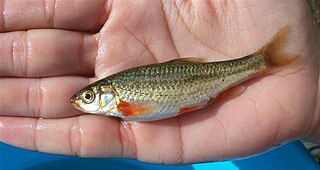 W
WAchondrostoma oligolepis is a species of cyprinid fish. It is endemic to central and northern Portugal and known from between Limia and Tornada drainages, south of Douro. It occurs in the lower stretches of rivers and streams. It can grow to 25 cm (9.8 in) total length, although it typically measures about 15 cm (5.9 in) TL.
 W
WAchondrostoma salmantinum is a species of freshwater fish in the family Cyprinidae. It is native to five tributaries in the Duero basin in the Province of Salamanca, Spain. It is normally found in clear, seasonal streams with sandy substrates, preferring the slower flowing stretches which have an abundant vegetation of aquatic macrophytes. The species is common within its restricted range but it has a declining population and it is threatened mainly by falling water tables caused by the abstraction of water for agriculture and the construction if dams and weirs.
 W
WAlburnoides bipunctatus, known vernacularly as the schneider, spirlin, bleak, riffle minnow, and others, is a species of small freshwater fish in the family Cyprinidae. It is found in Afghanistan, Armenia, Austria, Azerbaijan, Belarus, Belgium, Bulgaria, Czech Republic, Croatia, Estonia, France, Georgia, Germany, Hungary, Iran, Latvia, Lithuania, Moldova, the Netherlands, North Macedonia, Poland, Romania, Russia, Serbia, Slovakia, Slovenia, Switzerland, Turkey, Ukraine, and Uzbekistan. This fish inhabits rivers with very calm waters, and it eats dead insects and insect larvae, diatoms, and crustaceans. It reproduces during April to June.
 W
WThe Andalusian barbel or is a freshwater fish species in the family Cyprinidae. It is here placed in Luciobarbus following the IUCN, but that genus is very closely related to the other typical barbels and perhaps better considered a mere subgenus of Barbus. The Andalusian barbel was formerly included in L. bocagei as subspecies.
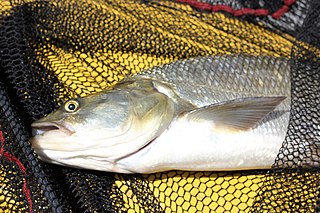 W
WThe asp is a European freshwater fish of the Cyprinid family. It is sometimes considered one of two members of the genus Aspius by some taxonomic authorities. It is protected under Appendix III of the Bern Convention and listed as least concern on the IUCN Red List.
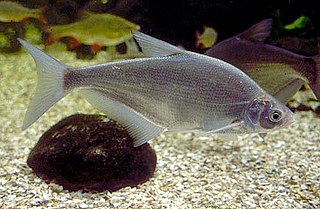 W
WBallerus ballerus, also known as the zope or the blue bream, is a species of cyprinid fish native to Eurasia.
 W
WThe Dnieper barbel is a species of cyprinid fish in the genus Barbus.
 W
WBarbus haasi, or the "Catalonian barbel", is a species of freshwater fish in the family Cyprinidae.
 W
WBarbus sperchiensis is a disputed species of cyprinid fish in the genus Barbus. It is a freshwater fish endemic to the Sperchios river complex, Central Greece.
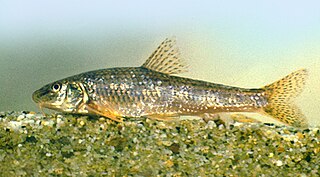 W
WThe Carpathian gudgeon is a species of gudgeon, a small freshwater in the family Cyprinidae. It is widespread in Europe in the Tisza system, Danube drainage in Ukraine. Freshwater demersal fish, up to 12.0 cm long.
 W
WThe common barbel, Barbus barbus, is a species of freshwater fish belonging to the family Cyprinidae. It shares the common name 'barbel' with its many relatives in the genus Barbus, of which it is the type species. In Great Britain it is usually referred to simply as the barbel; similar names are used elsewhere in Europe, such as barbeau in France and flodbarb in Sweden. The name derives from the four whiskerlike structures located at the corners of the fish's mouth, which it uses to locate food.
 W
WThe common carp or European carp is a widespread freshwater fish of eutrophic waters in lakes and large rivers in Europe and Asia. The native wild populations are considered vulnerable to extinction by the International Union for Conservation of Nature (IUCN), but the species has also been domesticated and introduced into environments worldwide, and is often considered a destructive invasive species, being included in the list of the world's 100 worst invasive species. It gives its name to the carp family, Cyprinidae.
 W
WThe common dace is a species of freshwater and brackish water ray-finned fish from the family Cyprinidae which is native to Europe but which has been introduced to other parts of the world. It is a quarry species for coarse anglers.
 W
WCyprinus carpio carpio is a subspecies of the common carp that is commonly found in Europe. They are native to much of Europe and can also be found in the Caucasus and Central Asia. Mitochondrial DNA analysis shows a difference between C. carpio carpio and Carpio carpio haematopterus. They are omnivorous in nature and feed on mollusks, insects, crustaceans and seeds. Though dark in color, there are some wild caught specimens which are colored orange. This subspecies has also been domesticated in European ponds for hundreds of years. They are considered as an invasive species in the state of Washington and fishing them is encouraged to diminish their population.
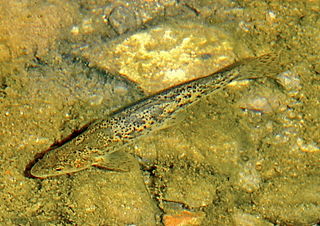 W
WThe Danube barbel is a species of freshwater fish widespread in southeastern Europe. It is difficult to diagnose from e.g. Barbus carpathicus and Barbus petenyi in the field.
 W
WThe Danube bleak or Caspian shemaya is a species of freshwater fish in the family Cyprinidae. It is found in Iran, Austria, Bosnia and Herzegovina, Bulgaria, Croatia, France, Germany, Hungary, Italy, Romania, Russia, Serbia, Slovenia, Turkmenistan, and Uzbekistan.
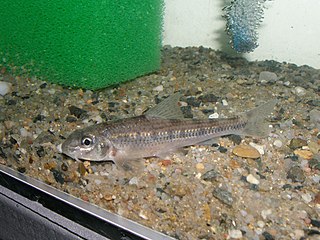 W
WThe Danube whitefin gudgeon is a species of freshwater fish in the family Cyprinidae. It is distributed in the Danube drainage. The maximal length is 11.5 cm, maximal reported age 4 years.
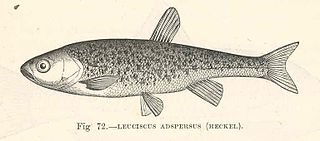 W
WDelminichthys adspersus is a species of cyprinid fish.
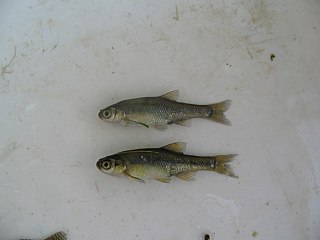 W
WThe epiros minnow is a species of cyprinid fish.
 W
WIberian gudgeon is a species of gudgeon, a small freshwater in the family Cyprinidae. It is widespread only in the Iberian Peninsula where it is indigenous in the Ebro and Bidasoa drainage, and in France in the Adour drainage, as well as Andorra. It has been introduced throughout the Iberian Peninsula, including Portugal, It is a freshwater demersal fish, up to 11.9 cm long.
 W
WIberochondrostoma is a genus of cyprinid fish endemic to the Iberian Peninsula.
 W
WLuciobarbus graellsii is a ray-finned fish species in the family Cyprinidae. It is here placed in Luciobarbus following the IUCN, but that genus is very closely related to the other typical barbels and perhaps better considered a mere subgenus of Barbus. The Andalusian barbel was formerly included in L. bocagei as subspecies.
 W
WLuciobarbus microcephalus is a ray-finned fish species in the family Cyprinidae. It is here placed in Luciobarbus following the IUCN, but that genus is very closely related to the other typical barbels and perhaps better considered a mere subgenus of Barbus.
 W
WThe Macedonian vimba or Malamída is a European freshwater fish species in the family Cyprinidae.
 W
WThe Mediterranean barbel or southern barbel is a species of ray-finned fish in the family Cyprinidae. It is found in France and Spain. It is one of the tastiest river fish, prized for its delicate texture and succulent flavor.
 W
WThe minnow-nase, Serbo-Croatian: podbila, is a species of freshwater fish in the family Cyprinidae. It is found in Bosnia and Herzegovina and Croatia. Its natural habitats are rivers, intermittent rivers, and inland karsts. It is threatened by habitat loss and considered Endangered (EN).
 W
WParachondrostoma arrigonis is a species of cyprinid fish endemic to Spain only found in the Júcar River basin. Its natural habitat is rivers. It is threatened by habitat loss.
 W
WParachondrostoma miegii is a species of cyprinid fish endemic to Spain, where it occurs in the basin of the Ebro and in one headwater of the Tagus. Its natural habitat is rivers. It is threatened by habitat loss.
 W
WPelasgus is a genus of cyprinid fishes that is only found in the Balkans. There are currently seven described species in this genus.
 W
WPelecus cultratus, commonly known as the ziege, sichel, sabre carp or sabrefish, is a cyprinid fish species from Eastern Europe and adjacent Asian regions, the only one in its genus, inhabiting the lower reaches of rivers and brackish waters in the eastern Baltic Sea, Black Sea, Caspian Sea and Aral Sea basins. The ziege having no major threats, the IUCN lists it as being of Least Concern.
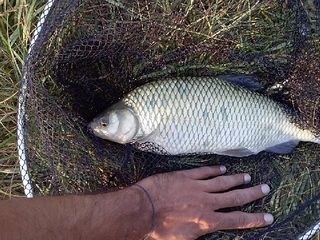 W
WThe pigo is a species of freshwater fish in the roach genus Rutilus of the family Cyprinidae. The fish is native to northern Italy and Switzerland. It inhabits subalpine lakes of the northern Adriatic basin from the Livenza to the Po drainage, including Lakes Maggiore, Lugano, and Como.
 W
WPseudochondrostoma willkommii is a species of cyprinid fish. It is found in Portugal and Spain. Its natural habitats are rivers and water storage areas. It is threatened by habitat loss.
 W
WThe common rudd is a bentho-pelagic freshwater fish, widely spread in Europe and middle Asia, around the basins of the North, Baltic, Black, Caspian and Aral seas.
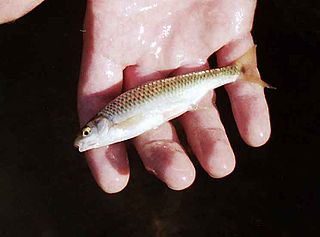 W
WSarmarutilus rubilio, known as the rovella or the South European roach, is a species of freshwater fish in the family Cyprinidae. It is native in the Tuscano-Latium district of Italy, both in waters draining to the Adriatic and Tyrrhenian Seas, and introduced further south in the country. Its natural habitats are rivers and freshwater lakes. It is threatened by introduced species and habitat loss.
 W
WThe South European nase is a species of cyprinid fish.
 W
WSqualius alburnoides is a species of fish in the family Cyprinidae. It is found in Portugal and Spain. Its natural habitats are rivers and intermittent rivers. It may be threatened by habitat loss.
 W
WSqualius ghigii, the Rhodes minnow, is a species of freshwater fish in the family Cyprinidae, also known as the gizani or ghizáni. It is currently considered to be endemic to the island of Rhodes, Greece. Its natural habitats are rivers, intermittent rivers, freshwater marshes, freshwater springs, and water storage areas. It is threatened by habitat loss.
 W
WSqualius janae, commonly known as the Istrian chub, is a species of freshwater fish in the carp family Cyprinidae. It was first described in 2010 from the Dragonja River drainage in Slovenia. Since then they have also been found in the Boljunčica and Pazinčica river drainages in Istria, Croatia.
 W
WThe tench or doctor fish is a fresh- and brackish-water fish of the order Cypriniformes found throughout Eurasia from Western Europe including the British Isles east into Asia as far as the Ob and Yenisei Rivers. It is also found in Lake Baikal. It normally inhabits slow-moving freshwater habitats, particularly lakes and lowland rivers.
 W
WVimba elongata is a European freshwater fish species in the family Cyprinidae. Inhabits the basin of upper Danube: alpian lakes of upper Austria and southern Bavaria.
 W
WThe white-finned gudgeon is a species of freshwater fish in the family Cyprinidae. It lives in the North Caspian basin in lower parts of the Volga and Ural River drainages. About 10 cm long.